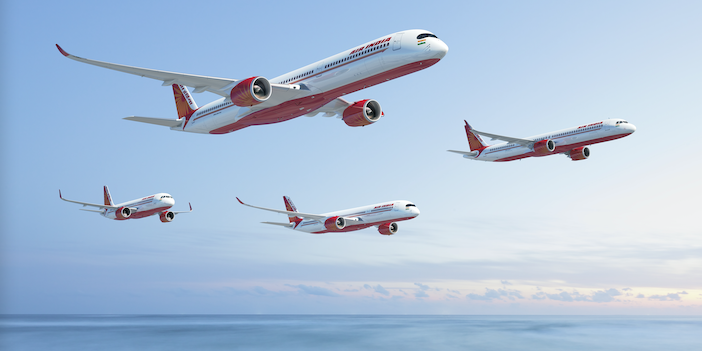Aviation has had a tough three years, caused by the effects of pandemic travel restrictions. As passengers return to the skies, including the Chinese market, all signs are that recovery is well underway, and aircraft orders are streaming in. Aircraft orders are important for the cabin interiors supply chain, the mood of which has been buoyed by bold statements of investment and confidence, such as Indigo Partners’ firm order for 255 additional A321neo Family aircraft placed at the 2021 Dubai Airshow, and United Airlines order in late 2022 for 100 Boeing 787 Dreamliners, with options to purchase a further 100, plus 56 additional Boeing 737 Max aircraft and options for 44 more. The latest big news could take things to another level, with the Air India group lining up the largest-ever commercial aircraft order.
Air India, part of the Tata Sons conglomerate, has signed letters of intent with Airbus and Boeing to acquire 70 widebodies – 34 A350-1000s, six A350-900s, 20 Boeing 787s and 10 Boeing 777-9s – as well as 400 single-aisle aircraft (140 A320neos, 70 A321neos and 190 Boeing 737 MAXs ( including 737-8s and 737-10s)). The airline has also included options for 20 more Boeing widebodies and 50 more Boeing narrowbodies.
The order is intended to both modernise and expand the airline’s fleet, with the objective of creating a larger and premium full-service carrier that will cater to the growing travel demand in the region. Indeed India is expected to grow to have the largest population in the world over the next decade, with its economy expanding the fastest among the G20 nations, and a burgeoning middle class that will spend more on air travel. As a result, passenger traffic in India is predicted to grow quickly, including on the long-range routes to the USA, Europe and Asia-Pacific.
The value of the orders has not been disclosed, but IBA, an aviation consultancy, has made some estimates. Based on list prices, the deals are valued at around US$68 billion, but IBA puts its market value of the order, based on early 2023 opinions, at around US$41-42 billion (including both firm orders and options). IBA says it is likely that the carrier secured a discount to market values, given the size of the orders.
Whatever the order value, it will mean big business for the aircraft interiors and IFEC sectors, with such orders for hundreds of new aircraft equating to orders for hundreds of cabin products, from galleys to lavatories, carpets to linings, and for thousands of seats, inflight entertainment (IFE) monitors, seat covers, seat belts, life vests… the list goes on.
According to Air India, the first of the new aircraft – an A350-900 – will enter service in late-2023, with the bulk of the deliveries due from mid-2025 onwards. In the interim, Air India has already started taking delivery of 11 leased B777 and 25 A320 aircraft to accelerate its fleet and network expansion programmes, both domestically and internationally.
The new aircraft will have entirely new cabin interiors, complementing Air India’s previously announced plan to refit its existing widebody B787 and B777 aircraft with new seats and IFE systems. The first of these refitted aircraft will enter service in mid-2024. According to Campbell Wilson, CEO and MD of Air India, the airline is aiming to elevate its on-ground and onboard product “to world-class standards”.
Commenting on the landmark deal, Natarajan Chandrasekaran, chairman of both Tata Sons and Air India, said: “Air India is on a large transformation journey across safety, customer service, technology, engineering, network and human resources. A modern, efficient fleet is a fundamental component of this transformation. This order is an important step in realising Air India’s ambition, articulated in its Vihaan.AI transformation programme, to offer a world-class proposition serving global travellers with an Indian heart. These new aircraft will modernise the airline’s fleet and onboard product, and dramatically expand its global network. The growth enabled by this order will also provide unparalleled career opportunities for Indian aviation professionals and catalyse accelerated development of the Indian aviation ecosystem.”

The Air India group comprises Air India – the full-service flag carrier airline of India – as well as two low-cost subsidiaries, Air India Express and Air Asia India, which are in the process of merging. Parent company, Tata Sons, recently announced its intention to merge Air India with Vistara, another full-service airline, which is a joint venture between Tata Sons (51%) and Singapore Airlines. Tata Sons has said that, subject to regulatory approval, the Air India group could soon comprise a single full-service airline, bearing the Air India name, and a single low-cost airline, named Air India Express.
Neil Fraser, IBA’s manager of airline analysis stated: “There have been rumours of a major order from some time, but its confirmation affirms Air India’s growth focus as they complete their merger with Vistara. Air India dominates India’s international operations, with capacity twice that of competitor Indigo in 2022. With this order containing such a significant number of narrowbody aircraft, IBA suspects that the new Air India may now be going after Indigo’s domestic market share. The domestic market has not been a major focus for Air India, whose flights have been a fifth of those operated by IndiGo.”
IBA’s fleet data indicates that the combined in-service fleets of Air India, Vistara and AirAsia India total 228 aircraft, 205 of which are active as of 15th February 2023. The combined fleet has an average age of 9.1 years, 4.5 years below the market average.
If all the new Air India group orders are completed, IBA anticipates that the combined fleet would total 682 aircraft, taking into account the likely retirement of the Boeing 737-800 from the existing Air India Express and Vistara fleets as newer-generation aircraft are delivered.





